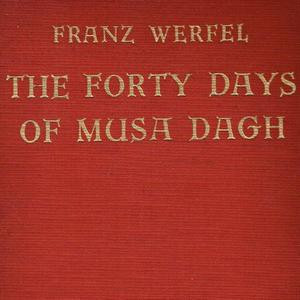The Forty Days of Musa Dagh
The Forty Days of Musa Dagh (German: Die vierzig Tage des Musa Dagh) is a 1933 novel by Austrian-Bohemian writer Franz Werfel based on true events that took place in 1915, during the second year of World War I and at the beginning of the Armenian Genocide. The novel focuses on the self-defense by a small community of Armenians living near Musa Dagh, a mountain in Vilayet of Aleppo in the Ottoman Empire—now in Hatay Province, part of southern Turkey, on the Mediterranean coast—as well the events in Constantinople (Istanbul) and provincial capitals, where the Young Turk government orchestrated the deportations, concentration camps and massacres of the empire's Armenian citizens. This policy, as well as who bore responsibility for it, has been controversial and contested since 1915. Because of this or perhaps in spite of it, the facts and scope of the Armenian Genocide were little known until Werfel's novel, which entailed voluminous research and is generally accepted as based on historical events. The novel was originally published in German in November 1933. It achieved great international success and has been credited with awakening the world to the evidence of the persecution and genocide inflicted on the Armenian nation during World War I. The Forty Days of Musa Dagh also foreshadows the Holocaust of World War II due in part to the rise of Adolf Hitler and Nazi Germany, which paralleled the novel's creation. In 2012, David R. Godine, Publisher, issued a revised and expanded English translation of The Forty Days of Musa Dagh that incorporates virtually all of the material left out of Geoffrey Dunlop's 1934 translation.
Download
- Part 1
- Part 2
- Part 3
- Part 4
- Part 5
- Part 6
- Part 7
- Part 8
- Part 9
- Part 10
- Part 11
- Part 12
- Part 13
- Part 14
- Part 15
- Part 16
- Part 17
- Part 18
- Part 19
- Part 20
- Part 21
- Part 22
- Part 23
- Part 24
- Part 25
- Part 26
- Part 27
- Part 28
- Part 29
- Part 30
- Part 31
- Part 32
- Part 33
- Part 34
- Part 35
- Part 36
- Part 37
- Part 38
- Part 39
- Part 40
- Part 41
- Part 42
- Part 43
- Part 44
- Part 45
- Part 46
- Part 47
- Part 48
- Part 49
- Part 50
- Part 51
- Part 52
- Part 53
- Part 54
- Part 55
- Part 56
- Part 57
- Part 58
- Part 59
- Part 60
- Part 61
- Part 62
- Part 63
- Part 64
- Part 65
- Part 66
- Part 67
- Part 68
- Part 69
- Part 70
- Part 71
- Part 72
- Part 73
- Part 74
- Part 75
- Part 76
- Part 77
- Part 78
- Part 79
- Part 80
- Part 81
- Part 82
- Part 83
- Part 84
- Part 85
- Part 86
- Part 87
- Part 88
- Part 89
- Part 90
- Part 91
- Part 92
- Part 93
- Part 94
- Part 95
- Part 96
- Part 97
- Part 98
- Part 99
- Part 100
- Part 101
- Part 102
- Part 103
- Part 104
- Part 105
- Part 106
- Part 107
- Part 108
- Part 109
- Part 110
- Part 111
- Part 112
- Part 113
- Part 114
- Part 115
- Part 116
- Part 117
- Part 118
- Part 119
- Part 120
- Part 121
- Part 122
- Part 123
- Part 124
- Part 125
- Part 126
- Part 127
- Part 128
- Part 129
- Part 130
- Part 131
- Part 132


